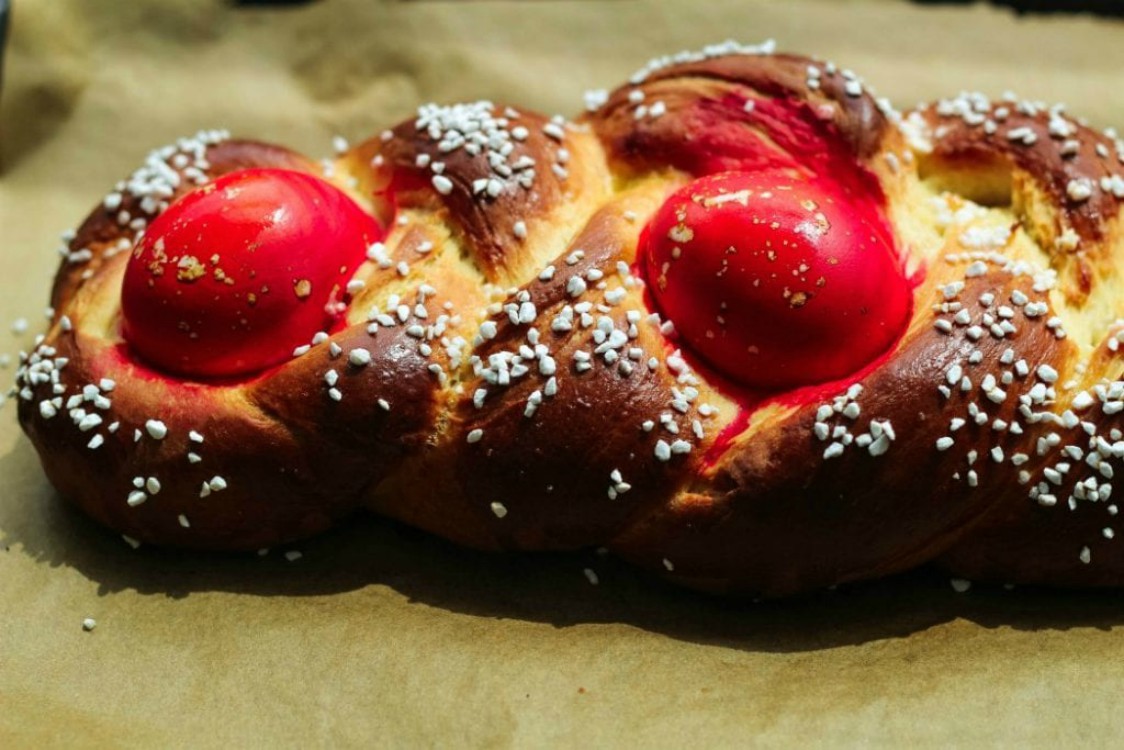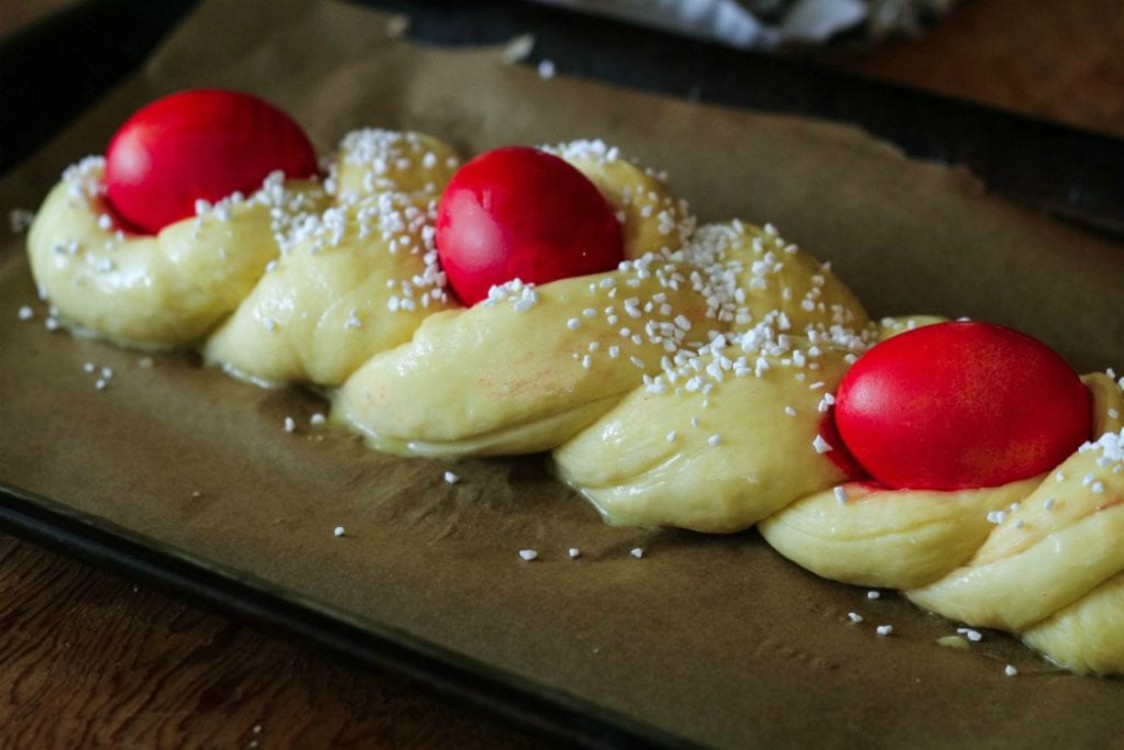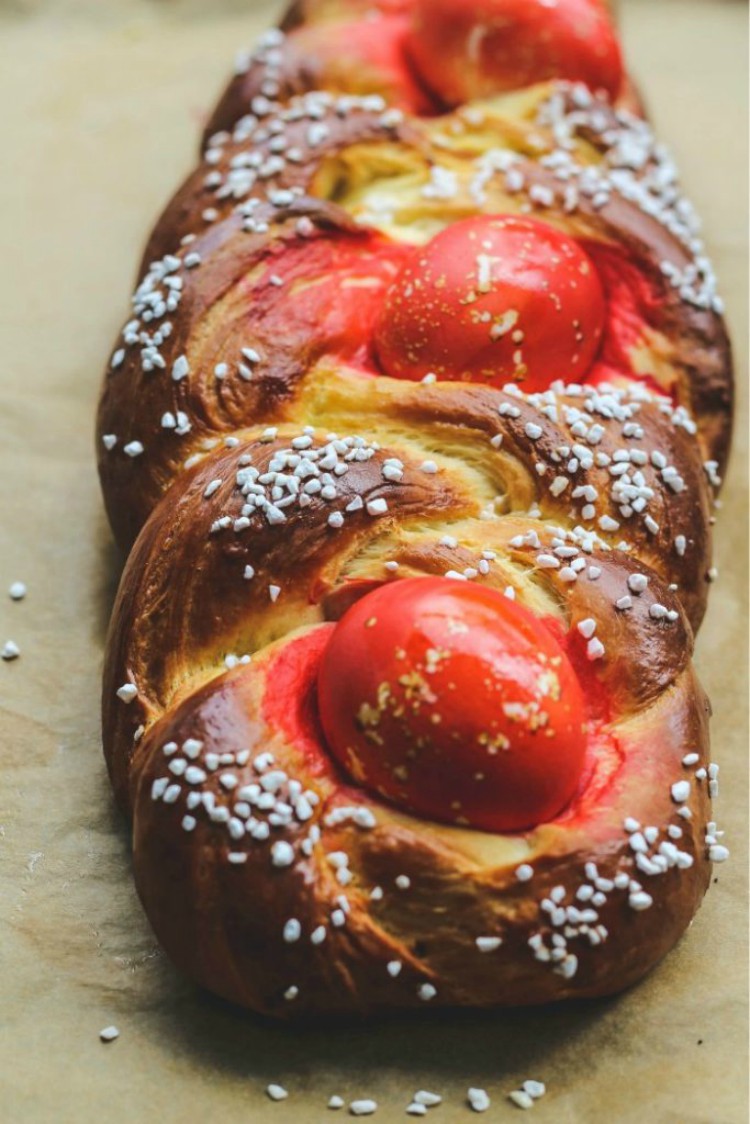
Greek Easter Egg Bread
You may be wondering why I am posting another Easter bread when Easter was last week. However, today is actually Greek Orthodox Easter and I’ve been wanting to dye red Easter eggs and share a tsoureki bread recipe for years.
I know, it seems silly. Who in their right mind would obsess about red Easter eggs? Me, that's who! I tried to make this Easter sweet bread a few years ago and used red dye, but I wound up with gorgeous hot pink eggs instead of red and felt very disappointed in myself. I couldn't understand how difficult it could be to dye red eggs if you're using red dye.
I gave up on my mission to share this Greek Easter bread and stuck to my traditional Italian Easter bread and moved on in my bread baking life. And just to warn you, I have one more Italian Easter recipe to share! It's taking me a while to upload the photos and edit them. That's part of the reason why I give up on posting recipes here as it takes me a while to get the photos together and choose the correct ones, edit them, and post here for all of you!! With patience I am getting to them all.
Basically tsoureki (tsoo-RHE-kee) is just a soft butter and egg brioche dough like the Italian Easter bread I make. The spices that are used to flavor the bread vary from region to region in Greece (like many Italian recipes). It could be made with kakoule (cardamom seeds). It could also be made using mahlepi seeds (or powder), which can be found online or in your favorite Middle Eastern market (we have a great one not too far from us). I have never baked with crushed mahlepi seeds or its powder, but know it is used in Middle Eastern baking.
I decided to use crushed anise seeds in place of the mahlepi seeds, as I wanted to use what I already have here and it is used in some Greek baking. In Greece, they color the eggs red on Holy Thursday to symbolize renewal, rebirth, and the blood of Christ. My Greek friends explained to me that they crack the eggs in a gentle and fun way against each other saying "Christos Anesti" (Christ has risen), and then saying, "Alithos Anesti” (he is risen).
My kids did not crack any red eggs against each other because that would just end in a disaster, but they did enjoy sharing this Easter egg bread with each other on Easter morning. As for the red dye, I did buy a packet of red dye from my local Middle Eastern Market and it worked much better than the liquid dye I used the first time.
You may be wondering why I'm sharing this Greek Easter bread recipe, as I'm not Greek. But the Sicilian in me must have some Greek ancestry. Ever since I was a little girl, I've been fascinated by Greek culture, the language, its traditions. Any Greeks who have a story or more to share about traditional Easter breads, please leave a comment! I would love to hear from you!

What’s Needed for Greek Easter Bread?
To make this Easter sweet bread, you’ll need:
- Milk
- Active dry yeast
- Eggs (both for dying and for mixing into the dough)
- Vanilla extract
- Granulated sugar
- All-purpose flour
- Lemon zest
- Aniseed
- Kosher salt
- Butter
- Pearl sugar (for decorating)
How to Make Greek Easter Bread
Although this tsoureki bread recipe requires some patience to make, it’s well worth the effort!
- Dye the Easter eggs according to package instructions.
- Add the yeast to some warm milk and let stand until frothy.
- Whisk the raw eggs and vanilla into the yeast mixture.
- Mix together the dry ingredients in the bowl of a standing mixer fitted with a dough hook attachment, then add the yeast mixture to it.
- Add the butter to the dough 1 tablespoon at a time.
- Turn the dough onto a floured surface and shape into a ball. Place the dough ball in a clean, oiled bowl and set aside to rise.
- Once the dough has doubled in size, gently punch down and braid the dough.
- Tuck the dyed eggs into the braid wherever you think is best.
- Place the braided dough onto a parchment paper-lined baking tray and let rise a second time.
- Brush the braided dough with egg wash and sprinkle with pearl sugar. Bake until done.
Can I Freeze Easter Egg Bread?
Yes, you can freeze this Greek Easter bread without the dyed eggs. You can freeze the entire loaf or whatever you have leftover after Easter.

Tips for Making Greek Easter Bread
It can take quite a while for the Easter eggs to turn the correct color, so you may want to dye them a day or two before making the bread itself.
The bread dough also requires extra time to rise. It should be made with lots of patience and love, as with any yeast dough.
Note that this tsoureki bread can be enjoyed year-round. Omit the dyed eggs if it’s not Easter and simply braid the dough without them!
More Easter Bread Recipes:
Greek Easter Bread (Tsoureki)
Ingredients
For the Dough:
- 1 cup milk
- 2 packets active dry yeast (two 1/4 ounce envelopes)
- 4 eggs , room temperature
- 1 tsp vanilla extract
- 1/2 cup granulated sugar
- 4 1/2 cup unbleached all-purpose flour (may need more as mixing)
- 1 Tbsp. lemon zest
- 1 tsp aniseed
- 1 tsp kosher salt
- 8 Tbsp. butter , room temperature (cut into 1 inch pieces)
- 4-6 dyed eggs
- pearlized sugar , to decorate
For the Egg Wash:
- 1 egg
- 1 Tbsp. water
Instructions
- If you are adding colored eggs, now is the time to color them. Follow the dye directions on the box or use natural dye and let the eggs sit for an hour. The longer they site the more vibrant the color.
- In a small saucepan heat the milk over medium to 110 F (I just test the water with my finger and know it’s the right temperature…warm like the temperature of a baby bottle, not hot). Add the yeast to a small bowl with the warm milk and whisk it around with 1 tablespoon of the sugar. Let sit until foamy (about 5 minutes).
- Whisk in the eggs and vanilla and set aside.
- In a large bowl whisk together the rest of the sugar, flour, lemon zest, aniseed and salt.
- Pour the flour mixture in the bowl of a mixer. With dough hook attached and mixer on medium speed, slowly add the milk mixture (*the milk mixture has the milk, yeast, 1 tbsp sugar, eggs, vanilla) to the flour mixture.
- In a large bowl whisk together the rest of the sugar, flour, lemon zest, and salt.
- Pour the flour mixture in the bowl of a mixer. With dough hook attached and mixer on medium speed, slowly add the milk mixture (*the milk mixture has the milk, yeast, 1 tbsp sugar, eggs, vanilla) to the flour mixture.
- Hold onto your mixer! Now you will add the butter 1 tablespoon at a time. I tell you to hold unto it because it will move around if you are mixing it on too fast of a speed. Start on medium-low speed. If you notice the mixer moving too much, you can lower the speed and let the butter get gently incorporated into the dough. If you have the mixture at a faster speed at this point…do not leave it alone while it’s mixing. It could bounce off the counter.
- Be sure to mix well when all the butter is added (about 3-5 minutes). You may need to add more flour. Don't worry about the total amount of flour, keep adding until your dough is stiff and it is not sticky.
- Put a little flour onto a clean counter and scrape the dough out of mixer onto the counter. Knead the dough a little and shape the dough into a ball (you won’t be kneading the dough too much…just a bit to shape it into an elastic ball of dough).
- Oil a large mixing bowl and place the dough into the bowl.Rub a little oil on top of the dough and cover it to rest in a draft-free area for a bout 1-1 1/2 hours. The dough will be doubled in size. Punch down the dough.
- If you are making one large braid, roll each piece into strips about 15 “ long. If you are making two braids, the strips will be a bit smaller (sorry, I did not measure the strips).Pinch the left side together to secure the three pieces and braid the 3 strips. Pinch the other side together on the right to secure it closed.
- The fun part is tucking in the eggs wherever you’d like it in between the braids and cover the dough with a kitchen towel for about 40-45 minutes. I tucked in 3 eggs in each braid. When dough is about ready, preheat the oven to 350 F. Mine was ready to bake at 40 minutes.
- Whisk together the egg and water for the egg wash and brush it on the dough avoiding the eggs. Sprinkle on the pearlized sugar (if using).
- Place the dough on a parchment lined baking pan and bake for about 25-30 minutes, or until golden brown. Check on your bread at about 25 minutes, you don't want it too brown.
Nutrition Disclaimer
Please keep in mind that the nutritional information presented below is an approximation and may vary depending on the exact ingredients used.





jovina says
How pretty.
Savoring Italy says
Thanks, Jovina! Hope you had a nice Easter!
Savoring Italy says
HI Mary, Thank you for leaving such an informative comment. I have heard that it has to be used sparingly because it could be better. What a great tip on how to crush it!I want to know more about your village sourdough bread. I appreciate your kind comment and thank you for visiting!